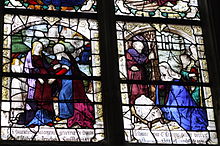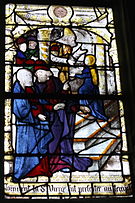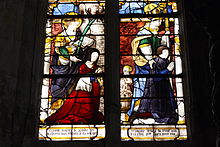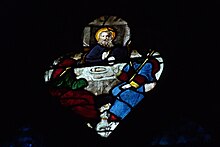St-Martin (Herblay-sur-Seine)
The Catholic parish church of Saint-Martin in Herblay-sur-Seine , a municipality in the Val-d'Oise department in the French region of Île-de-France , was built in several construction phases. The oldest parts go back to the 12th century. In the choir , which was renovated in the 16th century, lead-glass windows from the Renaissance have been preserved, including a Wurzel-Jesse window. In 1925, the church consecrated to Saint Martin of Tours was added to the list of architectural monuments in France as Monument historique .
history
During excavations between 1967 and 1971, over 50 sarcophagi from the Merovingian era were discovered near the church . They are made of plaster and partially decorated with pagan and Christian motifs such as wheel and cross. It is believed that the Merovingian cemetery also had a church, but nothing has survived.
In the 12th century the three- nave nave , the transept arms and the bell tower were built in the early Gothic style. In the 17th century, a porch was added to the west facade, in front of the 14th century portal , in which the parish held its meetings. In earlier times, travelers brought horseshoes to the portal in honor of St. Martin on.
architecture
Exterior construction
The square bell tower covered with a hipped roof rises above the crossing , the upper floor of which is pierced on all four sides by high, pointed arches of sound . The outer walls are structured by strong buttresses , above which protruding gargoyles are attached to the choir, under the roof approach .
inner space
The arched arcades that open to the north aisle are dated to the early 12th century. They lie on pillars whose figurative capitals still have Romanesque influence. The pointed arch arcades to the south aisle were built a little later. With their bud capitals, they are ascribed to the end of the 12th century.
In the crossing , the original ribbed vault has been preserved. The vaults of the main and side aisles were renewed in the middle of the 19th century.
Leaded glass window
The church has numerous stained glass windows from the 19th century depicting apostles, saints and martyrs, as well as scenes from the life of Jesus. Most of the windows have the signature of Louis-Victor Gesta, the founder of a stained glass factory in Toulouse . The two windows depicting the martyrdom of St. Julia of Corsica and the finding of the cross by St. Helena bear the signature of the glass painter Charles Lévêque from Beauvais .
The following stained glass windows in the choir date from the 16th century:
- Scenes from the life of Mary
|
Scenes from the life of Mary can be seen on a window: the visitation , the birth of Christ, the adoration of the Magi and Mary at the spindle. |
- Annunciation and Temple Walk
|
On another window, the Annunciation , the Walk to the Temple and the donor family with St. Barbara pictured. The latter can be recognized by the martyr's palm and its attribute , the tower. |
- Pietà
|
A window shows Mary with the body of Jesus. Behind her stand the apostles John and Mary Magdalene . CHASTELLAIN , the name of the glass painter Jean Chastellain , can be read on the rim of her precious ointment vessel . |
- Nicholas legend
|
A window tells an episode from the legend of St. Nicholas , who saves three girls from prostitution by throwing a sack with a golden ball through the window each. In the lower part of the window are the donors with their patron saints, St. Barbara and St. Nicholas, depicted. |
- Root Jesse
|
The Wurzel-Jesse-Fenster is very similar to the Wurzel-Jesse-Fenster in the Martin Church in Groslay in the Val-d'Oise department. Presumably the same boxes were used as a template. |
- Representations in tracery
|
In the smaller slices of the tracery of the lancet include the Emmaus disciples , God the Father and Jesus in the hostage column visible. |
Furnishing
- The font dates from the 12th century. The oval stone basin is made from one piece and decorated with round bars on the upper edge .
- The holy water font bears an inscription which contains the year 1627 and the name of its founder, Martin Auger. The upper edge is decorated with four angel heads.
literature
- Jean-Marie Pérouse de Montclos (ed.): Le Guide du Patrimoine. Île-de-France . Hachette, 2nd edition, Paris 1994, ISBN 2-01-016811-9 , p. 334.
- Georges Poisson (ed.): Dictionnaire des Monuments d'Île de France . Éditions Hervas, Paris 2001, ISBN 2-84334-002-0 , pp. 394-395.
- Le Patrimoine des Communes du Val-d'Oise . Flohic Éditions, Volume 1, Paris 1999, ISBN 2-84234-056-6 , pp. 387-391.
Web links
- Église Saint-Martin in the Base Mérimée of the French Ministry of Culture (French)
Coordinates: 48 ° 59 '14.8 " N , 2 ° 9' 36.7" E



















